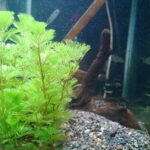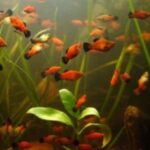21 years ago, my father set up an aquarium on top of my dresser…I’ve been hooked ever since. But until 2 years ago, I’ve always kept just plain gravel as my substrate. I loved the look of sandy and grassy bottoms but swore they would be to hard to maintain. I just KNEW I didn’t have the time to commit to what I insisted would be a daunting and relentless task of cleaning. How on earth would that sand stay down when I did regular water changes, “Vacuuming” the bottom. I tried live plants several, handfuls of times and they always ended up withering away and dying…of getting some horrible algae bloom all over my pretty little plant. Eventually the algae would just eat the plant or I would get mad about the algae outburst and flush the plant down the toilet.
Then my grandma would take me to one of her best friends houses and I would be introduced to the world of truly live aquariums. One of Molly’s main hobbies is her aquariums. My grandmother met her thru being the president of the African Violet Society Of Pinellas County and I knew she could grow violets, but I had no clue she could grow what I refer to as “Aqua Gardens.” The last time I saw her. She had 8 fishtanks and every single one looked like a lush jungle with fish happily darting about. I was hooked. All I can do is move from chair to chair in her family room and gaze off onto her tanks for hours.
So she gave me her receipe for what she claimed was THE substrate to have. I’ve outlined it all in my article “How to Set Up A Live Planted Aquarium.” And that got me started. Then came extra lighting for those plants and then learning to use CO2 Injectors, also outlined in my article Do It Yourself CO2 Injector. After that, you really have a good setup for most plants. Of course if you get into some really exotic plants, you may have to look into adding different supplements. But, with the mixture I use for substrate and with the addition of CO2 injection, you will have plants multiplying so fast that you’ll either set up to sell to your local pet store or even sell your extras on E-bay!
But now that you’re all set up, the time is going to come where you’ll need to start doing some routine cleaning and water changes. It will run much smoother if you keep designated items for your tank(s) and all together. You’ll need a large bucket, I use a Vac type gravel cleaner, a toothbrush to remove traces of algae, pair of scissors for trimming dead leaves, a hand towel and a couple large towels for under my set-up to catch my droplets.
Before you drain your water, I find it best to do your light brushing of the inside glass. Get any algae, no matter how small, brushed off the sides and any rocks, etc. Most of it will end up on the bottom of your tank within a few minutes for you to easily suck up.
After you’ve given your tank a few minutes for the sediments of your algae scrapings to settle, prepare to vaccuum. It really doesn’t differ from vacuuming gravel. You will quickly learn how close you can get to the sand and if you stuck a little up, no big deal. The idea is to just get the stuff floating atop the sand and it all really comes up quick and easy. You won’t have to get as close to the sand as you may think.
I personally clean out about 1/4 tanks worth of water, give an inch or two depending on what’s going on with the tank. I have live bearers in my largest tank and if I didn’t already realize, nothing makes you realize you have babies quicker than a routine tank cleaning! Don’t worry much about the temperature of the water you’re adding back being a few degrees cooler in unless it’s smaller than 20 gallons. All my fish seem to enjoy it, some even swim in the fresh, cooler water being added. Even my plants look greener and happier. I have very good well water with special filters so, if you live on public water than you need to add water conditioners or fill old water jugs up and let set for at least a few days to release chlorine and a few other contaminates. If you have a well, run tests on your water so you know your perimeters and can make adjustments to your water as needed.
I find the best time to trim or pull of dead or decaying leaves from plants is while you have your water drained. You won’t have to get as wet either! Some plants that are thinner stemmed and well rooted, you can just give a quick tug at the base of the plant and the stem will easily break away. Larger, thicker stemmed plants will require a pair of sharp little scissors. Look for the possibilities of overcrowding and move things if needed, replant any desired plants. And I always look for what possible things I want to move or trim before I even drain and yes, sometimes you’ll still reach down into the tank to move or pluck something after you’ve added all your water back in and think you’re finished with it. I’m telling you, it’s an addiction.






